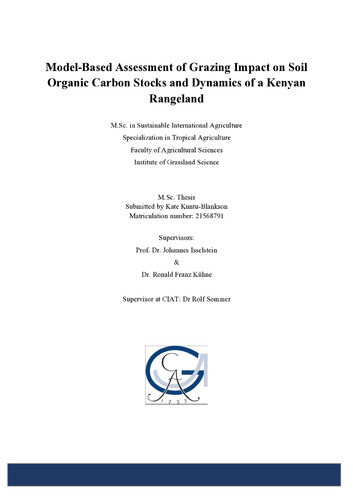Model-Based Assessment of Grazing Impact on Soil Organic Carbon Stocks and Dynamics of a Kenyan Rangeland
As the largest terrestrial ecosystem carbon (C) sink, soils store about 2500 Pg C in the top 1 m depth. Rangelands make up around 40 % of global land surface and contain about 30 % of global terrestrial soil organic carbon (SOC). Grazing is the most important use of rangelands worldwide which when managed properly, can make rangelands potential sequesters of significant amounts of previously lost C. This will not only offset anthropogenic C emissions and contribute to climate change (CC) mitigation but also improve soil quality and productivity to ensure food security in the worlds’ poorest regions. Rangelands in East Africa cover 75 % of the total land area, but despite the importance outlined, little scientific studies have been carried out to quantify the effects of grazing management on SOC sequestration potentials and there exists a knowledge gap. The heterogeneous nature of rangelands worldwide makes it impossible to generalize grazing management recommendations across different regions as same studies have produced different results in comparable places.
We aimed to investigate the long-term effect (30 years) of four grazing regimes on three selected sites under mid-future CC scenarios of the Representative Concentration Pathways (RCPs) 4.5 and 8.5 on SOC stocks of a rangeland in Southern Kenya. Heavy (HG) lead to SOC losses in all sites with the most loss of 206 kg C ha-1 observed on one sandy site “sand_light”. Moderate grazing (MG) increased SOC stocks in all three sites, the highest of 141 kg C ha-1 occurred at our clay site “clay_heavy”. RG (yearly rotation) and ALT (monthly rotation) caused SOC to increase only for the clay_heavy site. We observed small reductions in SOC stocks from the baseline scenario with a more negative impact of RCP4.5 than RCP8.5 but the observed differences were not dramatically different. The possible reasons for higher SOC stocks under RCP8.5 could be attributed to higher primary productivity of the C4 grassland under elevated CO2 and also more production of lignified plant materials that are less decomposable. We conclude that grazing management and soil texture will be the major factors controlling SOC stocks dynamics in the future as major differences was observed under those than under the CC scenarios.

